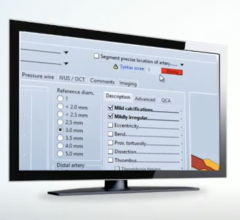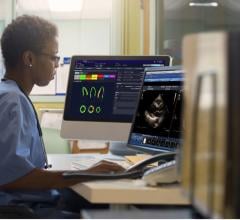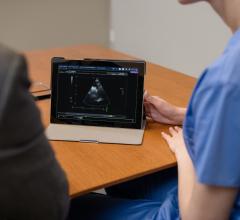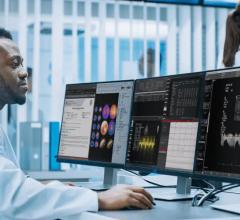
Doctors Butchko and Suarez discuss an echo in the cath lab control room, on the Horizon Cardiology hemo system.
Digging through boxes, waiting for couriers, finding smashed VHS tapes in the mail, jockeying back and forth between multiple modalities. Like at other hospitals across the country, the manual, tape- and film-based workflow in the pediatric cardiology department at Mercy Children’s Hospital in Toledo, Ohio, had stagnated, quadrupling the time it should have taken the cardiologists to read echocardiograms for the hospital and four outreach centers, resulting in a report turnaround time that could be as long as five to seven days.
The hospital implemented a fully digital solution, Horizon Cardiology from McKesson, a single-platform cardiovascular imaging and information system (CVIS). Since implementation, cardiologists can access all inpatient and outpatient echocardiograms and cardiac catheterizations from one workstation and even do side-by-side comparisons and re-measuring on the same screen. The drastic improvements in workflow efficiency enable the cardiologists to read studies more quickly and accurately. Today, the vast majority of signed reports are typically distributed to the enterprise and the referring pediatrician within 24 hours of the cardiologist seeing the patient, and for emergency cases can be distributed in under an hour.
Build It and They Will Come
In 2001, the parent organization for Mercy Children’s Hospital, Mercy, implemented Horizon Cardiology. At that time, the CVIS was designed for the adult population; however, officials saw the benefit of having a standardized CVIS across the health system as it moved to an electronic medical record. With that in mind, Mercy Children’s Hospital served as the beta site for building a pediatric echocardiography module, extending the adult version with congenital disease templates, graphical measurement trending and Z-score calculations that fit the pediatric cardiology population.
“We moved from a horrible manual process where tapes were put back on the machine to measure or compare with a previous study,” explains William Suarez, M.D., chief of pediatric cardiology and associate professor at Mercy Children’s Hospital. “With Horizon Cardiology, we have no reason to have tape anymore, and I can instantly see everything I need from one reading station. As soon as I sign the report, it’s instantaneously in the electronic patient record.”
Suarez and the team of cardiologists use the system’s comparison features to see the trending of measurements over time, especially crucial in pediatric patients as they get older. Because of the single database, all of the multi-modality studies are online and instantly available. The cardiologist can see the entire list and can then directly compare one or more previous studies to the current one.
Mercy’s cardiologists also use the CVIS to perform offline measurements after the images have been sent from the echo cart. Although the technologists perform the bulk of the measurements on the carts, occasionally the cardiologists will use the CVIS’ measurement tools to perform additional measurements.
“In the past, we would have to look up the old tape, print the image and still not know the proper scale,” says Gary J. Butchko, M.D., FAAP, a pediatric cardiologist at Mercy Children’s Hospital. “The CVIS is extremely accurate for re-measuring, and the image quality is 10-fold better. We can read studies more quickly and accurately, and the patient isn’t inconvenienced because we can recheck immediately. Even in outlying, rural hospitals, I can report while the patient is still in the lab. It happens so quickly you would think I was reading for a patient in our own facility.”
Cardiologist convenience is also important. Two years ago, Mercy Children’s Hospital added remote functionality so cardiologists could read echocardiograms and caths from home. Butchko estimates that he now reads 75 to 80 percent of his studies from home because the high-speed Internet environment mimics the hospital’s stable environment.
“Remote access allows me to increase my professional and personal proficiency,” states Butchko. “Let’s say I have a lot of echos from the outpatient clinics to read tonight. By logging in from home, I can still finish within the parameters set by the hospital and meet my family obligations. That’s phenomenal.”
Better, Faster, Safer Care
Since moving to the McKesson CVIS, Mercy Children’s Hospital has overhauled its report generation process. In the past with tapes, the cardiologists would write notes on sheets of paper and the echo tech would need to decipher the notes. Outpatient readings used to take approximately one week for the report to reach the pediatrician. If the cardiologist was reading quickly, it might drop to one to three days. However, with the CVIS, turnaround time has been reduced to 10 minutes from the procedure to final report delivery to the pediatrician.
Those results are catching the attention of the satellite clinics, according to Suarez. “At first, everyone balks at price, but they don’t realize the savings. There is no longer the expense for creating and mailing tapes or CDs. Even more, the time savings far outweigh the price of the system. We have shown our outreach clinics that if they log into our system, we can read their studies in only a few minutes.”
And you can’t put a price on patient care. Reducing the amount of wasted time the cardiology department spent on manual processes allows more time to be devoted to patient care.
“The CVIS has helped us improve our overall efficiency,” states Butchko. “If we do an echo and determine a baby needs surgery right away, we can get the echo reported, signed, documented and sent to the surgical team within a few hours, and the surgeon can pull up the echo to use as a guide during the surgery.”
Another significant impact, adds Suarez, is the ability to catch a potential mistake. “When we are reading a referral, we can prevent a physician from letting a patient go that needs to be looked at further. The CVIS gives us the ability to prevent morbidity because we can provide accurate, efficient and prompt diagnosis.”
This case study was supplied by McKesson.


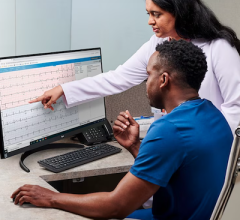
 November 06, 2025
November 06, 2025 


